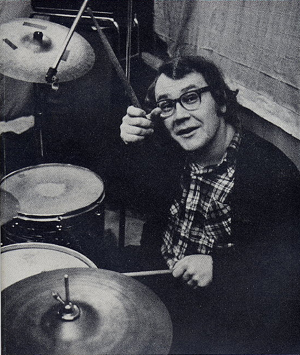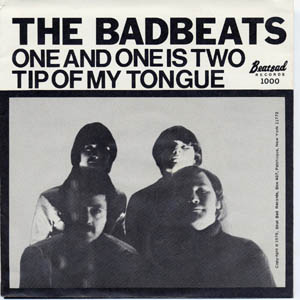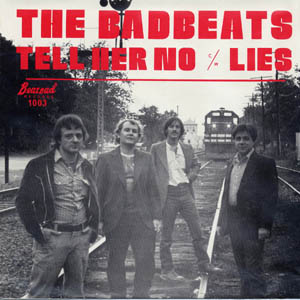
BILL KERN BIOGRAPHY - Page 3
The response to Tip of My Tongue and One
And One Is Two, encouraged them to release more
records. The first release on Beat Bad Records after The Badbeats was Bill
Kern's first solo record, You're Not Coming
Home and Don't Listen To Them. We
all believed that both songs were strong enough to be considered 'A' sides, and
felt that whichever of the two songs was not on the 'A' side would not be given
its due attention. It was therefore decided to make the record a double
'A' side, but not in the conventional sense. Both songs were placed on the
same side of the record, sort of like a one sided EP. Still concerned that
the first song would be considered the 'A' side, we decided to make two versions
of the record, reversing the order, and as long as we were going to the
trouble to master the songs twice, we decided to use completely different mixes
of the songs. The main difference being in the stereo spread and effects,
and some instruments are doubled on one version and not on the other.
Although the official catalog number for the record is 1001 for both versions,
we always referred to each version by its matrix number (the actual number of
the master). Most people didn't understand the concept behind the two
versions, but it was one of the unique ideas that made Beat Bad Records stand
out from the hundreds (maybe thousands) of independent labels at the time.
The line-up was the same as The
Badbeats' Lies. So essentially, this could have been another
Badbeats single. With very few exceptions, everything that Bill Kern
and Barry Knoedl recorded featured the two of them with one or two other
musicians, including Ray Knoedl (lead guitar), John Sheridan (drums and guitar),
Joe Schillace (rhythm guitar and background vocals), Thorne Ventura (lead
guitar), and Jimmy Yeager (synthesizer). I Just Want To Make You Happy,
the 'B' side of Barry Knoedl's Death Records release featured Barry Knoedl, Bill
Kern on drums, Ray Knoedl, and Joe Schillace. It was the only recording
with all four of the members of The Badbeats pictured on the second Badbeats release.
 |  | |
Bill is in the lower right |
Bill is second from the left |
The next project was in
the works for close to two years. Barry's eldest brother, George Knoedl,
had bought an electronic drum box in the late 60's called a Rhythm Ace.
This is a similar device to the electronic drums that began appearing in home
organs in the 70's, except that it was a stand alone. George was an
electronics engineer who worked for Brookhaven National Laboratories, Viewlex,
Grumman's, and Bell Labs (the engineering and design branch of AT&T).
The Rhythm Ace was a fun little toy, but very limited in its repertoire.
It could play about a dozen basic 2 bar patterns in variable tempos.
George, who always liked to tinker with anything electronic, redesigned the unit
to play more complex drum patterns. He also increased its capacity by
allowing you to select multiple patterns simultaneously. He also made a
pedal to allow you to manually play the bass drum and cymbal, and two additional
buttons for snare rolls in eighth notes and triplet fills. Bill was always
fascinated with this device and wanted to use it on a recording along with other
experimental sounds. The resulting project was Hound Dog, coupled with a song that Bill wrote to go along
with it called You Ain't
No Friend Of Mine.
Nearly ten minutes long, Hound Dog/You Ain't No Friend Of Mine, was the
first dance record in the new wave/punk genre. It was released as a 12
inch 45, a format reserved for disco at the time. The 'B' side was Radio In U.S.A., a punk song with a decidedly 50's feel. On
the 12 inch, Radio In U.S.A. had an a capella tag, which was actually a
separate song called Listen To
The Radio. This tag came
about spontaneously while recording Radio In U.S.A. While recording
the vocals, as the song ended, Barry Knoedl started singing the bass vocal line
heard in the tag. Bill liked the sound so much, that he wanted to expand
it. So Bill and Barry began building vocal tracks on top this original
line. There had always been the intention of releasing these songs on a
tradition 7 inch single (catalog #1006), with Hound Dog/You Ain't No Friend
Of Mine cut down to reasonable 3:43, or Hound Dog alone clocking at 2:03, and Radio In U.S.A. without its
tag, but it was never released in that format.
Bill and Barry continued
to record, even after Beat Bad Records ceased making records. They
completed an LP by The Badbeats around the same time
that Hound Dog was completed. The LP contained 17 tracks, including
10 Lennon/McCartney songs, Tell Her No and Lies, and 5 new songs by Bill Kern,
Barry Knoedl, and Jerry Leshaw (a close friend). Between 1979 and 1984,
Bill and Barry recorded six albums worth of original songs. All recorded
on 4 track tape. In 1984, they upgraded their recording studio to 16
track. Their production style changed dramatically, because there were
fewer limitations on what they could fit into a recording. Around this
same time, synthesizer technology advanced, and became much more
affordable. This also had a major impact on their production. Over
the next ten years, they recorded over sixty new songs. In the late summer
of 1994, they decided to complete a project they began planning in December of
1981, a Christmas album of all new Christmas songs. In November of 1994,
Beat Bad Records saw its first release since 1981. Merry Christmas From
Bill And Barry. Thirteen new Christmas songs written by Bill Kern and Barry
Knoedl were issued on audiocassette. The CD version was released in
September of 1995. The releases saw some minor local interest, but remain
largely unsold.
|
